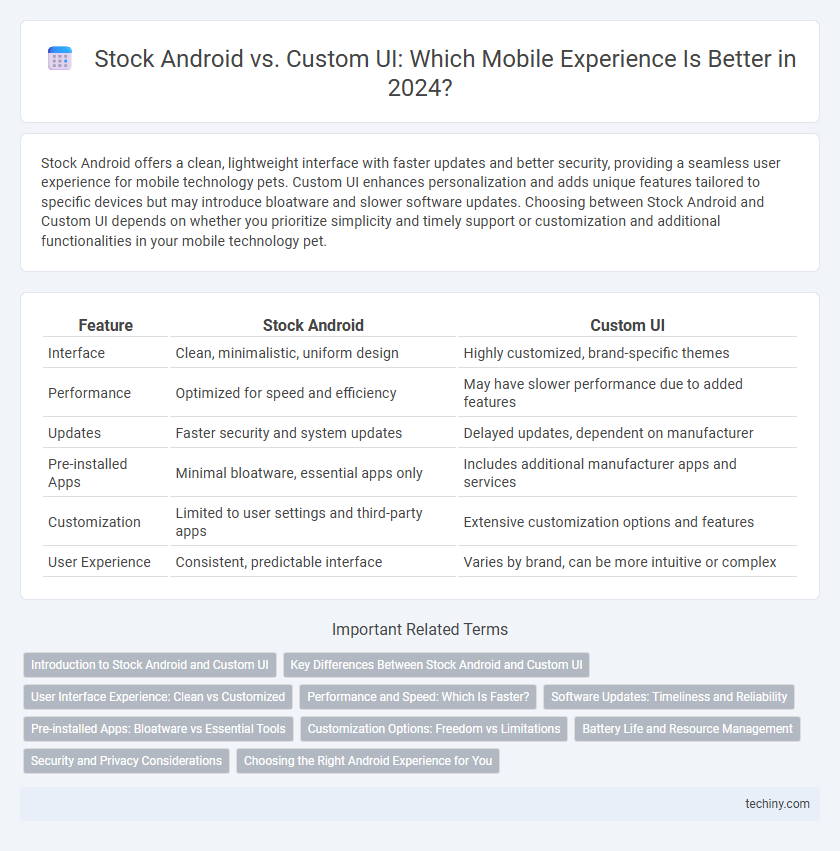Stock Android offers a clean, lightweight interface with faster updates and better security, providing a seamless user experience for mobile technology pets. Custom UI enhances personalization and adds unique features tailored to specific devices but may introduce bloatware and slower software updates. Choosing between Stock Android and Custom UI depends on whether you prioritize simplicity and timely support or customization and additional functionalities in your mobile technology pet.
Table of Comparison
| Feature | Stock Android | Custom UI |
|---|---|---|
| Interface | Clean, minimalistic, uniform design | Highly customized, brand-specific themes |
| Performance | Optimized for speed and efficiency | May have slower performance due to added features |
| Updates | Faster security and system updates | Delayed updates, dependent on manufacturer |
| Pre-installed Apps | Minimal bloatware, essential apps only | Includes additional manufacturer apps and services |
| Customization | Limited to user settings and third-party apps | Extensive customization options and features |
| User Experience | Consistent, predictable interface | Varies by brand, can be more intuitive or complex |
Introduction to Stock Android and Custom UI
Stock Android is the pure version of Google's mobile operating system, offering a clean interface and timely software updates without additional manufacturer modifications. Custom UIs, developed by device manufacturers like Samsung's One UI or Xiaomi's MIUI, provide enhanced features, personalized themes, and proprietary apps tailored to specific hardware. These custom interfaces often include added functionalities such as gesture controls, battery optimization, and multitasking enhancements that differentiate them from the minimalist Stock Android experience.
Key Differences Between Stock Android and Custom UI
Stock Android delivers a clean, bloatware-free experience with timely updates directly from Google, ensuring better security and performance optimization. Custom UIs, developed by manufacturers like Samsung's One UI or Xiaomi's MIUI, offer enhanced features, deeper customization, and unique app integrations but often delay Android version updates. The choice depends on user preference for pure Android simplicity versus feature-rich, visually distinct interfaces tailored to specific brand ecosystems.
User Interface Experience: Clean vs Customized
Stock Android delivers a clean and minimalist user interface, prioritizing simplicity and fast performance without unnecessary bloatware. Custom UIs offer tailored features and design elements, enhancing personalization but sometimes at the cost of system fluidity and increased resource usage. Users seeking a pure and responsive experience often prefer Stock Android, while those valuing unique aesthetics and additional functionalities lean toward Custom UI.
Performance and Speed: Which Is Faster?
Stock Android delivers faster performance and smoother responsiveness by minimizing background processes and eliminating unnecessary bloatware, resulting in optimized system resource management. Custom UIs often introduce additional features and animations that can impact speed and increase RAM consumption, leading to slower app launch times and reduced multitasking efficiency. Benchmark tests consistently show stock Android devices achieving higher frame rates and lower latency, making them preferable for users prioritizing speed and fluid performance.
Software Updates: Timeliness and Reliability
Stock Android ensures faster and more reliable software updates compared to custom UIs, as updates come directly from Google without manufacturer delays. Custom UIs often experience significant lag due to additional testing and personalization layers, which can compromise timeliness and security patches. Users seeking prompt access to the latest Android features and security improvements benefit from choosing devices running Stock Android.
Pre-installed Apps: Bloatware vs Essential Tools
Stock Android offers a clean experience with minimal pre-installed apps, reducing bloatware and maximizing device performance. Custom UIs often include additional pre-installed tools and apps tailored by manufacturers, which can be useful but may slow down the device and consume storage. Users prioritizing efficiency prefer Stock Android for its lean setup, while those seeking enhanced features might opt for custom interfaces despite the extra apps.
Customization Options: Freedom vs Limitations
Custom UIs offer extensive customization options, allowing users to personalize themes, icons, and system behaviors beyond Stock Android's basic settings. Stock Android emphasizes simplicity and consistency, often limiting customization to maintain a streamlined user experience. The freedom provided by Custom UIs appeals to enthusiasts seeking unique device personalization, while Stock Android's limitations ensure stability and faster updates.
Battery Life and Resource Management
Stock Android offers a cleaner interface with minimal background processes, resulting in better battery life and efficient resource management compared to custom UIs. Custom UI layers often include pre-installed apps and additional animations that can increase power consumption and slow down system performance. Users seeking optimal battery longevity and smoother task handling typically prefer Stock Android for its lightweight and streamlined design.
Security and Privacy Considerations
Stock Android provides a cleaner, more secure environment with timely security patches directly from Google, minimizing vulnerabilities commonly exploited in custom skins. Custom UIs often introduce additional layers and pre-installed apps that can increase the attack surface and compromise user privacy due to inconsistent update schedules. Users prioritizing robust security and privacy should consider Stock Android's streamlined codebase and prompt updates over the feature-rich but potentially riskier custom interfaces.
Choosing the Right Android Experience for You
Stock Android offers a clean, bloatware-free interface with timely updates directly from Google, ensuring optimal performance and security. Custom UIs like Samsung's One UI or Xiaomi's MIUI provide added features, enhanced customization, and manufacturer-specific optimizations tailored for diverse user preferences. Selecting the right Android experience depends on prioritizing software purity and update speed versus extra functionalities and unique design elements.
Stock Android vs Custom UI Infographic

 techiny.com
techiny.com